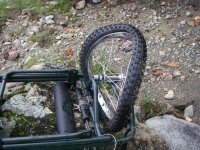Two years ago, based on the majority of recommendations from experienced Adirondack wheelers, I bought a Cabela's steel cart at a bargain $71--also known over the years as Swedish Boat Cart/Canadian Boat Walker/Pacific Outdoors/Instep/LL Bean/Paddleboy All-Terrain Center Cart. I got it specifically to do a 70 miler from Blue Mountain Lake to Tupper Lake, which includes the steep 1.5 mile carry around Raquette Falls.
It worked, but was tough work on the mountain goat trails in the high 80's heat.
The center position is necessary because you are sometimes going up hill, sometimes down; sometimes pulling, sometimes pushing; sometimes at the side of the cart to prevent it from tipping over. Reposition the load so it's over the wheels. This model has a kickstand, which is very helpful to keep the cart steady when loading it. Angle the straps fore and aft, even more than I have on this easy carry trail.
Having slotted inwales, as all tripping canoes should, helps to angle, position and hold the straps in multiple locations.
On steep goat trails the heavy load can get away from you. Here, I've lost control going down a steep trail and the canoe is wedged sideways. It takes muscle and planning to get it out of jams.
Technique improves. I went from a class 1 wheeler (dumping on an easy trail) to a class 4 wheeler (never dumping again) over the course of the trip. Nevertheless, on the Raquette Falls carry there are many gullies, washes and boulder blockades--which a shoulder carrier would simply step over or around--that completely stymie forward progress when wheeling. This simply requires brute strength pulling or pushing to get out of the ditch. If necessary, you would have to remove gear to lighten the load.
This model cart has a small pump and patch kit, which I taped to the frame. Flats are a real issue. In fact, the cheap tires go flat in two weeks in the garage. Before using the cart again I would probably get high quality tubes from a bike shop and whatever type of tube sealer that is available.
The wheels fold inward, so it can easily fit low in the bow of the deep Hemlock SRT. My daypack is aft of it in this configuration.
Later on, I got too lazy to keep folding the cart, so I just put it in the bow with the wheels locked in position. I put my daypack on top of the frame in between the wheels. That worked well.

